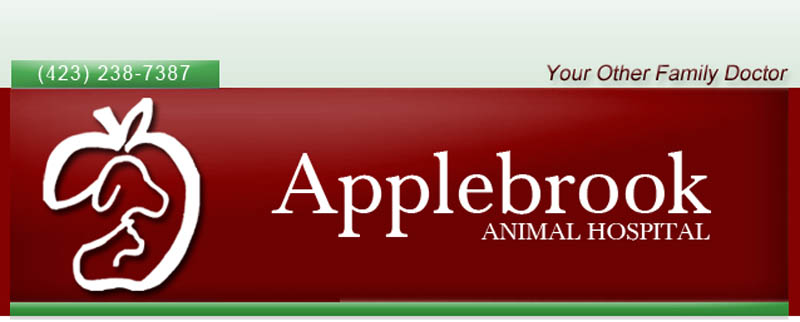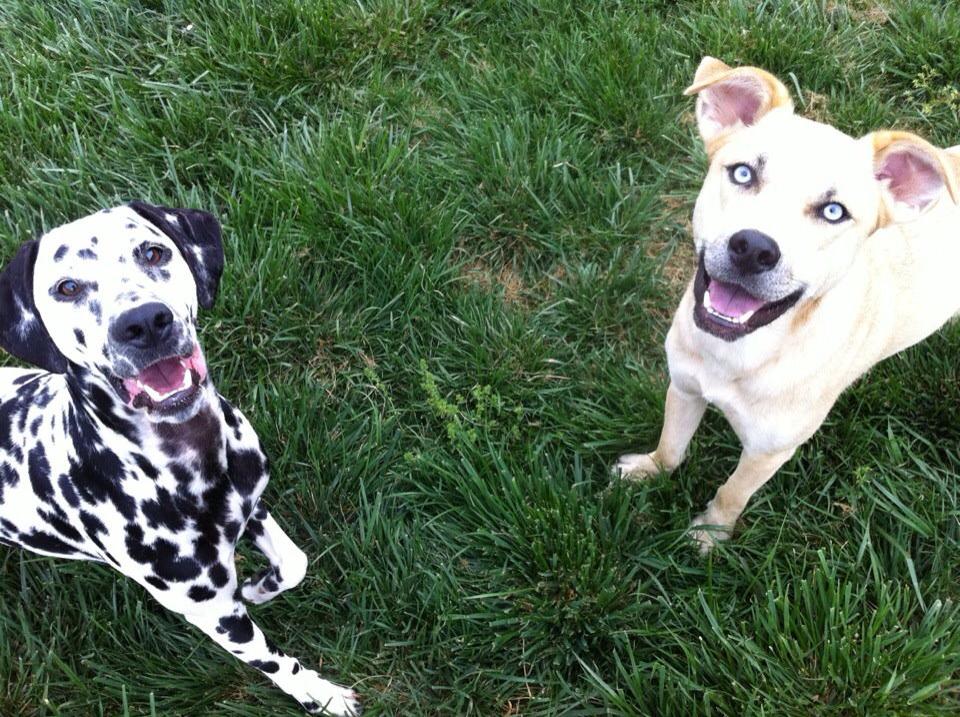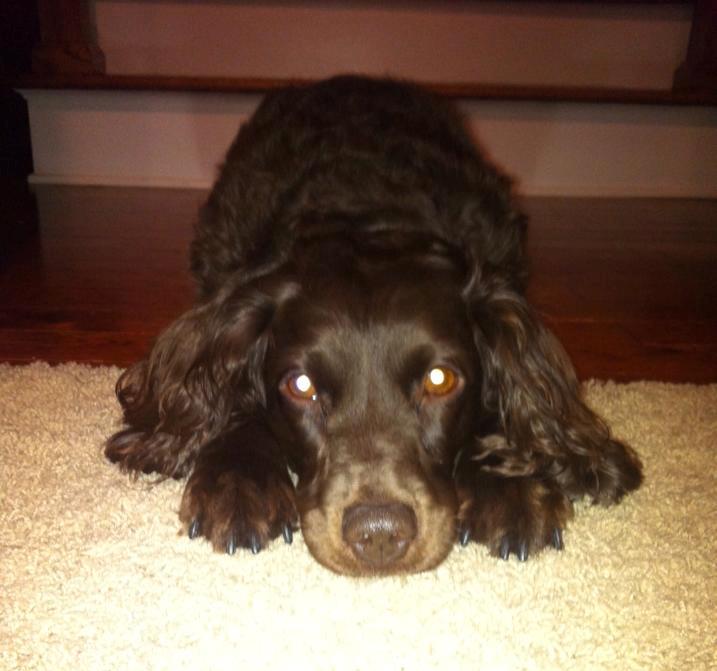Dr. Primm's Warm and Fuzzies
Just take him out and shoot him????
by Kathryn Primm DVM on 02/21/13
A man came into the hospital this week with his cat in his arms. No one recognized him or the cat, but he said that he needed to be seen by the vet. I was in a procedure with an anesthetized pet and could not leave her, so my staff assessed the cat to make sure he was stable enough to wait for me and then offered the next available appointment time to the man. He then asked what the charge would be for his cat to be seen. The staff member explained the examination charge. The man then loudly proclaimed that the charge was "as much as a real doctor!" He then turned on his heel, declaring that he would "just take him out in the yard and shoot him" and was gone. The staff member was visibly shaken by the encounter.
To that man out there and others like him:
1. I am a real doctor, having attended 4 years of undergraduate study, receiving a BS in Biological Sciences and spending the 4 years in Veterinary School. I rotated through internships and externships and I am a very competent and caring professional, as are all of my staff members.
2. This is a business. We have to pay our staff and vendors to be able to do what we do. If we don't, we won't be here to help any animals or people at all.
And thirdly and most importantly, threatening your pet in order to hurt and get back at us because we did not tell you what you wanted to hear is not acceptable anywhere. It is against the law in Tennessee to "take him out and shoot him" and it is just plain WRONG. When you accepted that pet, you accepted responsibility for his care. If you cannot afford the care, please take him to a shelter so he does not suffer.
Ok, I am stepping off my soapbox now. I must remember that most people are good people and that the few that are not stand out more. There are people who stop for injured animals every day and no one ever knows it. There are people who are grateful every minute for the love of an animal. There are those that recognize our dedication and thank us for what we do. I will not let this man ruin my belief that people with pets are the best people in the world!
Kathryn Primm, DVM
An old Kat and New Tricks?
by Kathryn Primm DVM on 02/12/13
Today is my birthday (32 again!!!) and I have had a request to address some of the special needs of the aging pet, so I thought it would be specifically appropriate to write my blog about this today.
It is well known that aging is an expected and natural process. It is not technically a disease. Things just age and break down over time. We can use what we know about body systems and what we know about aging to tweak things to slow the progression a little bit. So here is my educated (and somewhat "up close and personal") opinion on the matter:
Body Weight
Obesity shortens life and speeds up the consequences of aging. This has been shown in scientific studies (Purina's life span study in 2002 found that normal weight Labs outlived their obese counterparts by an average of 1.8 years). It is also common sense to know that one's joints are going to wear more slowly if they bear less of a load. The same study found that the average age of the dogs requiring treatment for a chronic condition was 12 years for the lean dogs versus 9 years for the obese ones. We know from human models that abominal obesity creates extra workload on the heart and the list goes on and on. So keep your senior pet trim and you will reap the rewards of a longer and happier life.
Medical Care
I know it sounds like gratuitous self promotion for me to say "include your vet in your older pets care", but it is astoundingly true. A few years age, I did a retrospective look at our patient records and I found that the average age of death for our patients was almost 12 years. (And you know, of course, that our clients are wonderful and follow our suggestions better than most!) As an educated and objective observer, I can sometimes see things about your pet that you have not noticed being so close. Do not miss frequent physicals on your older pet. We suggest a thorough exam every 6-12 months and routine wellness testing for common age associated diseases once a year. I was involved in a conversation at my son's school the other day. Two of my longterm senior patient owners were talking to a new client with a senior pet also. She was saying how she was astounded that she still has her dog and how they never thought she would live this long (she is 14). One of the long term clients said, "Surprised good or surprised bad? Because if you do not want her to live long, don't go to Dr. Primm!" I was flattered and pleased, but I know it is true. Careful monitoring for older patients does make a difference.
Diet and Supplements
It is true that you are what you eat and so is your pet. Your dog is an omnivore like you are and if you start with a high quality premium diet and add in selected whole foods, you will be doing your dog a service. There are lots of high quality premium foods on the market and if you read this blog, you know that I like Royal Canin diets. My senior Great Dane eats Mobility diet to help with her aging joints. I feel that they have done their due diligence in research to substantiate their claims and I know that since I have been carrying the diets, they have never had a recall. Another thing that I swear by is Omega 3 supplements. Omega 3 supplements have shown promise in reducing inflammation in chronic skin conditions and improving joint lubrication. Some human studies suggest a decrease in cancer-associated inflammation also.
So, premium pet food base diet and supplement with whole, low fat choices and pet formulated omega 3 supplements. I do not recommend giving human supplements to pets and always give my
pets the ones that are formulated and tested for their specific
species. Cats are not tiny dogs, any more than dogs are tiny humans. When it comes to food choices to share with your pet, here is my rule: If you would not eat it or would not want your doctor to know you ever ate it, do not give it to your pet. This includes things that are downright toxic to pets like chocolate, but also fatty things like ground meat, BBQ and food that is potentially spoiled (like when you clean the refrigerator out and give stuff that is iffy to the dog). Good choices (IN MODERATION) might include: Whole grain breads, vegetables, like squash or green beans and some fruits for your dog and stick to lean meats for your cat.
Dental Care
We know that dental infections spread to the liver and heart, but also that dental disease is very painful. If you want your pet to live long and prosper, don't ascribe to the notion that bad breath is ok for pets. It isn't. If the breath is bad, there is infection. I believe that our aggressive dental program is a big part of our impressive longevity numbers. Let your vet flip your pet's lip and tell you what is needed. It makes a difference.
So if you are hoping that your pet will be there with you for years to come, read and follow this blog. Ask me questions and submit comments. Start reading labels and be selective for your pet. Have him/her evaluated by a vet for body condition score and wellness testing. Make sure she does not have visible tartar and bad breath. Aging is a natural process, but we do not have to take it lying down!
Guest Blog: How A Vet Examines an Animal's Eye
by Kathryn Primm DVM on 01/31/13
I would like to thank Dr. Bill Miller for his appearance as our guest blogger this week. Dr. Miller is a Diplomate of The American
College of Veterinary Ophthalmologists. He is the only boarded animal
eye specialist in west Tennessee, all of Arkansas and north Mississippi and was one of my professors along my veterinary journey. He assists me on cases still and is a terrific mentor to me. ~KP
How a Veterinarian Examines an Animal's Eye
Examination of a veterinary patient is not much different from the eye examination physician ophthalmologists perform on human patients. The exception is that it is very difficult to get veterinary patients to read an eye chart. Since most eye problems initially present with only signs such as redness and discharge, a complete eye examination should be performed whenever these signs are observed.The initial diagnostics that are done on almost all veterinary patients will include a Schirmer Tear Test, an Intraocular pressure, dilation, if medications are prescribed, corneal staining. A Schirmer Tear Test measures the eye's tear production. Veterinarians will perform this test anytime the eye is red and has discharge. The test is performed by taking a tear test strip and placing the end between the lower eyelid and eye. The amount of moisture wicking up the strip in a minute is measured. Normal values vary between species but for the dog 20 mm +/- 5 mm in 1 minute is considered normal. A focal light source is then used to examine the eyelids, structures surrounding the eye, and front half of the eye. The Pupillary Light Reflex (PLR) is determined for both eyes. The direct PLR is the response of the pupil shown directly in an eye while the consensual PLR is the response of the pupil in the contralateral eye from the one in which the light is directed. Intraocular pressure (IOP) is measured with a tonometer. An elevated IOP may indicate glaucoma. One of the first signs of glaucoma may be redness and discharge so measuring IOP is an important diagnostic test to prevent elevated IOP from blinding an eye. Once intraocular pressures are determined to be within normal limits the pupils are dilated. Typically dilation will take 10 to 30 minutes to complete, with pupils remaining dilated for about two hours. A variety of ophthalmoscopes may be used to examine the back or fundus of the eye. When examining the fundus the veterinarian is looking at the number and character of blood vessels, size and shape of the optic nerve, pigmentation of depigmentation, retinal anatomy, and intensity of tapetal reflectivity (the tapetum is the part of the back of the animal's eye that reflects light back out of the eye). Once the internal structures of the eye have been examined and prior to prescribing topical medications the cornea is often stained with fluorescein dye. The dye will adhere to corneal structures if there is a break in the cornea's epithelial surface and indicating an ulcer is present.
Once a
complete ocular examination is performed, primary care veterinarians may seek
consultation with a board certified veterinary ophthalmologist. Following consultation, therapy may be
prescribed by the primary care veterinarian or referral to the specialist may
be determined to be in the patient's best interest. The diagnosis and treatment of veterinary
ocular disease requires a team approach incorporating the owner, primary care
veterinarian and often veterinary eye specialists.
Guest Blog about Royal Canin pet food
by Kathryn Primm DVM on 01/28/13
I am starting a series of Guest Blogs to teach you all about everything from the products we carry to the services we offer and the best ways to care for your pets.
Today's blog is by Gregsby Gibbs about why he he thinks that Royal Canin is the best diet choice for your pet. We tend to agree. Enjoy!
Google the name "Simon Sinek" and you will find one man's take on WHY. It's not the WHAT or the HOW but the WHY that sets great companies apart. Don't believe me? Look at major brands such as Apple Computers and you will find this concept hard at work. Of course you buy the latest iGadget but the reason you bought it is not because of the device, which is really cool, but because Apple has stuck to their guns and been a company who through the years didn't strive to bring products to the forefront but instead focused on the ideas and WHY they were building devices. The WHY is key to their business plan and they have been very successful as a company.
People buy from companies because of WHY they do what they do, not WHAT they do. That is one of the explanations as to why great brands exponentially lead the pack. Many times their competitors actually have a better product. Many times the competition is better capitalized. Yet the company who best identifies what motivates them, and WHY they are doing what they are doing run circles around the pack.
The WHY for Royal Canin started with its funding some 40 years ago in the South of France with its founder Jean Cathary, DVM. He believed in the "pet first" approach which is still evident today. His thought was to put out the best nutrition for cats and dogs with all the research and knowledge he had at his disposal.
WHY? He saw so many dogs and cats in his practice that were
merely surviving and not thriving. With that in mind, he set out to put
the best nutrition in a bag that he could possibly make.
Royal Canin's commitment has continued through the years and it is still at the core of what we do which is make the best, nutritionally appropriate, food we can. We produce all of our own food in our own factories.
WHY? Producing your own food gives you control over every aspect of your food and with the strictest quality control we are able to produce the safest food on the market. We do so because it is the best way to control all aspects and that is the best for the pets we feed.We also use the latest research to come up with the best and most accurate nutritional formulas on the market for specific disease states in both cats and dogs.
WHY? We believe that the quality of a pet's life is important. We want your cat or dog to be the best he or she can be.
All of these WHY(s) are just a few of the things that set us apart as a company who will always but the cat and dog FIRST!
When I started working for Royal Canin I had no idea the care and
technology used to produce the food. I did have a Royal Canin dog,
an 11 year old chocolate lab. We had tried supplements and other
forms of nutrients to supplement her aging structure. She was barely able
to get up in the mornings and when it was really cold outside she would lay on
her bed all day. It was not until we had her on the Mobility Large Breed for 6
weeks did I know WHY.
It was because my vet was committed to carrying the best products and recommending the best medicine of the market. My vet had my pets best interest at heart. After 6 weeks on the food she was back up and meeting me at the door in the morning and begging for me to throw the frisbee again.
I could not ask for a better company to work for than Royal Canin. They are all about the pet and putting them first in every aspect. From quality control to studies, Royal Canin is at the forefront of the Prescription pet food industry and the WHY is what is all about.
Gregsby Gibbs
GIRL SCOUT COOKIES!!
by Kathryn Primm DVM on 01/21/13
We have a sign-up sheet for Girl Scout cookies at our front desk right now! My favorite is Tag-a-longs. One of our clients has a little Girl Scout and we are helping her sell. They are a wonderful guilty pleasure and they are a great cause. This is the same troop that invited me to be a guest speaker last year. Come and order yours!







